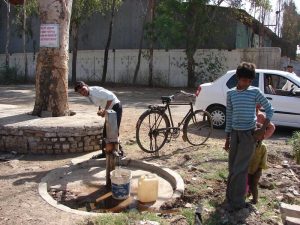In a new study, researchers found that about 20 percent of river basins have already reached their limit, where groundwater extraction from the ground exceeds that of the stream.
 Photo: Ankur Paliwal
Photo: Ankur Paliwal
Groundwater is the most commonly used source of fresh water throughout the world. According to statistics , about 200 crore people globally today depend on it for their daily needs and irrigation. According to estimates, 20 percent of the world’s population depends on crops irrigated by groundwater. The pressure on these reserves, which are already under pressure to meet the needs of the rapidly growing population and the continuous increase in crop production, is increasing.
Due to the rapid and uncontrolled way in which we are exploiting groundwater, these groundwater sources are depleting rapidly. On the other hand, these groundwater sources are not being recharged by rain and rivers. Analysis of satellite data obtained by NASA has revealed that the water level of 13 of the world’s 37 major groundwater sources has reached the danger mark. The rate of recharge of groundwater there is much less than the rate of its exploitation. The problem of falling groundwater level is becoming more serious in areas where intensive agriculture is done. Also, due to this, the pressure on rivers to supply water to the agricultural sector is increasing day by day. Assessments show that by 2050, its widespread and serious impacts on rivers, lakes and wetlands around the world will become apparent.
To understand this, an international team of researchers has attempted to measure the rate at which existing groundwater is being mixed into rivers and lakes. Which is called flow of current. He has also studied how the exploitation of groundwater for agriculture has affected this process. The researchers found that about 20 percent of river basins have already reached their limit, where groundwater extraction from the ground exceeds that of the stream. This study has been published in the international journal Nature.
Scientists have also used climate change models to predict how river flows will decrease in the future. In which they found that 42 to 79 percent of the world’s groundwater sources will be exhausted by 2050. Due to which they will be unable to maintain their ecosystem. Inge de Graaf, chair of environmental and hydrological systems at the University of Freiburg in Germany, explained what devastating effects this could have in the future.
According to the graph, it is very clear that if there is no water in the stream then definitely the plants and animals living there will die. Also, more than half of the crops which depend on groundwater for irrigation will also be destroyed. According to this latest study published in Nature, in the valleys of Ganga, Indus and Mexico, where dependence on groundwater for crop production is high, river flow is decreasing due to uncontrolled exploitation and as Africa and Southern Europe The demand for groundwater is increasing in the areas where the impact of serious water crisis will be visible in the coming few years.
The situation is serious in India also
Globally, groundwater is exploited the most in India, where 230 cubic kilometers of groundwater is used every year, which is about a quarter of the global use of groundwater. Scientists have estimated that in North India, which is the main wheat and rice producing region of the country, groundwater is depleting at the rate of 5,400 crore cubic meters per year. A report released by NITI Aayog had also expressed concern over the continuously decreasing groundwater level. According to him, by the year 2030, the decline in groundwater in the country will take the form of the biggest crisis. By 2020, groundwater in 21 cities including Delhi, Bengaluru, Chennai and Hyderabad will be on the verge of depletion.
It is noteworthy that to deal with the groundwater crisis, the Modi government had proposed ‘Atal Groundwater Scheme’ in March 2018. Which was to be implemented with the help of the World Bank in a five-year period from 2018-19 to 2022-23. Its goal was to ensure proper and sustainable management of groundwater with everyone’s participation in the seven states of Gujarat, Haryana, Karnataka, Maharashtra, Madhya Pradesh, Rajasthan and Uttar Pradesh, which are facing serious groundwater crisis. But due to lack of Cabinet approval, this scheme has been stuck for the last one and a half years.
How can there be a solution?
Recently, the Intergovernmental Panel on Climate Change had warned in one of its assessments that by 2050 the global population will cross 1,000 crore. It also explained how the threat of global warming can be tackled through proper water management in the agricultural sector. De Graaf noted that many places in the world have achieved success in limiting groundwater use through agricultural techniques, such as in parts of the Mekong Delta in Southeast Asia where water-intensive rice crops were grown as a pilot project. Coconut is being cultivated in place of sugarcane crops.
If we do not wake up today, our future generations will have to face such a groundwater crisis, the effects of which will be no less than a time bomb. Because of the uncontrolled way in which we are exploiting this resource, and due to this the pressure on groundwater sources is increasing. The consequences would be dire as it would take decades to refill these underground water systems.
Neerain is proud to republish this article for spreading awareness about situation of water, for our stakeholders. Credit whatsoever goes to the Author.
This article is published by: –
Author: Lalit Maurya
Publish On: 04 October 2019
